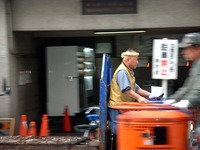 |
| Angelika/Mike Schilli |
|
Michael With Japan's "Shinkansen" train (pronounced "Shinkan Senn" with a soft 's'), the equivalent of the German ICE, we sped from Tokyo to Hiroshima, then to Kyoto, and finally, with local trains, to a sacred Buddhist mountain at Koya-san. If you, as a foreigner, pay about 250 euros per week, you can get a so-called JR Rail Pass, which allows you to use all trains of the Japanese railway JR, except for the super-fast "Nozomi," and travel across the country. The trains run precisely on time, are super clean, and only stop in major cities —- a nearly futuristic world if you're coming from America.
Because Japanese people, when they go on vacation, absolutely have to bring back gifts (called O-miyage) for their colleagues, these are naturally offered at train stations and even on the train. Additionally, as shown in illustration 3, there are pretty Eki-(station)-Bento boxes available for purchase, which -- typical Japanese -- contain all sorts of delicacies (mostly fish-based) in square compartments for immediate consumption.
In illustration 4, you can see Navigator Angelika waiting at the train station. Please note our luggage, which, for easier identification on the airport conveyor belt ("Which black Samsonite was mine again?"), carries a logo with three stripes that I personally designed. By the way, Japanese people travel with very light luggage -- with our two huge bags, we were constantly looked at in amazement, and I had to repeatedly help the slight hotel staff with carrying the suitcases, otherwise they would have collapsed.





































